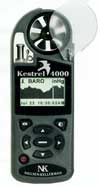|
The Answer Is Blowing in The Wind: the Kestrel 1000 Wind Meter  At a recent range session, testing some mild velocity loads using typically low ballistic coefficient muzzleloading projectiles (0.162), the amount of wind drift was remarkable. It's always windy here in Illinois, though some claim it is just myself. Yet another unsubstantiated rumor! We set up large butcher-paper backed targets at 100 yards, both "with" the wind that was gusting from 24 to 31 miles per hour, and at right angles so that we had a direct crosswind. Though our guns were grouping right at 1.5" shooting with the wind on our backs, the same 1.5" groups were blown to the left well over a foot on the cross-draft targets! It was evident to us that this could easily result in a crippled or lost animal, if not a clean miss, at extended ranges. Many common inline muzzleloading hunting loads fall within the general spectrum of the .45-70 Government cartridge. The factory 300 grain Remington factory load exhibits a frisky, by muzzleloading standards, 1810 fps muzzle velocity and has a ballistic coefficient of .213. As a point of comparison, one of the more common inline muzzleloading combinations is a full notch down from this: a Hornady XTP 240 grain saboted pistol bullet has a Lyman documented BC of .205, and when pushed by two 50 grain Pyrodex pellets, and has a muzzle velocity of 1690 feet per second. Assuming a premium load in the .45-70 Government genre, a 10 mph cross wind results in a bullet drift of 2.9 inches at 100 yards and over a foot at 200 yards. If we bump up our cross wind speed to 25 mph, the results are more vivid: 7.24 inches at 100 yards and a whopping 30.84 inches at 200 yards. To disregard the wind is to inherit it. So, though few argue that "proper shot placement" is the all-important axiom for humane harvesting of animals, "doping" the wind leaves many of us a bit dopier than we might think. Just like laser rangefinders have offered me a constant reminder of my own internal ranging limitations, the "Kestrel 1000 Pocket Wind Meter" has done the very same thing. It will quickly humble you, as it has me. The Kestrel 1000 is truly a wonderful product. It is manufactured by Nielsen Kellerman of Chester, Pennsylvania, and weighs only 1-1/2 ounces. It is accurate to plus or minus 3 %, is drop tested to six feet, water-resistant, and it floats. Powered by one CR2032 battery offering a typical life of 400 hours, it is intuitive to use; one need hardly refer to the instructions. There are three basic modes: current wind speed, maximum three-second gust, and average wind speed. Included is a rugged plastic case to protect the LCD during rough handling when not in use, which is easily removed if you prefer. It automatically shuts off after thirty minutes of no button presses, and if that isn't enough, the display indicates your choice of mph, knots, meters per second, kilometers per hour, feet per minute, or even Beaufort force. Best of all, it is remarkably affordable at a street price of about $69.00. The slower your projectile velocity, the more it is affected by the wind, and the farther your target distance is the more desperately you need this product. It is been a long time since I've been so impressed by a compact hunting and shooting tool. Whether you are a muzzleloading, air rifle, bow hunting or long range big game hunting enthusiast, this is a product that will make you more effective in the field. If you have not already guessed, this is one hunting instrument that I cannot recommend too highly. Wind management is an area that has been sorely overlooked for far too long. |